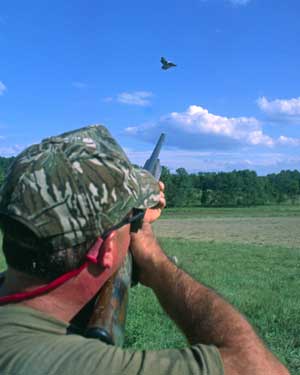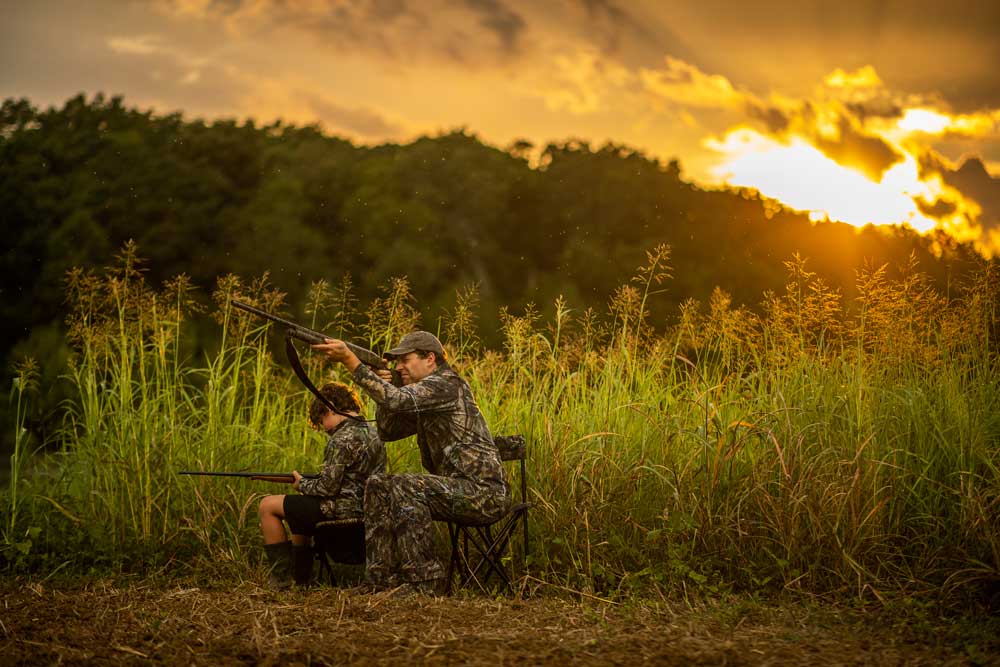John Phillips
Use Proper Gun Position, Learn Where to Point and Find the Best Lead
I never attended a dove shoot until I was a sophomore in high school. However, I started hunting doves in an abandoned area close to my neighborhood from the time I was 12 years old and received my first J.C. Higgins’ bolt-action .410 shotgun. Today there are few dove hunters but plenty of outdoorsmen who attend large field annual dove shoots.
Use Proper Gun Position:
 One dove hunter who’s excelled in taking doves on dove shoots told me that most hunters allow the stocks of their guns to get too far out on their arms or their shoulders, instead of cradling the stocks of their guns into their shoulders. Then they can't put their heads in the proper position to aim correctly. They'll have to lean their heads to the side to get their heads down on their stocks and look down the ribs of their barrels.
One dove hunter who’s excelled in taking doves on dove shoots told me that most hunters allow the stocks of their guns to get too far out on their arms or their shoulders, instead of cradling the stocks of their guns into their shoulders. Then they can't put their heads in the proper position to aim correctly. They'll have to lean their heads to the side to get their heads down on their stocks and look down the ribs of their barrels.
When the gun's in the wrong position, you’ll lose your depth perception. To shoot accurately, keep your eyes as level as possible. Simply raising your eyebrows up on one side of your face can cause you to shoot incorrectly. When you bring the gun to your shoulder, your arm makes a pocket in your shoulder for the gun to fit in naturally. If your gun is positioned correctly in the pocket of your shoulder, all you have to do is lay your cheek down on the stock to see and aim properly. When a dove hunter's shoulder or arm is blue from the recoil of a gun, you know he hasn't had his shotgun seated correctly in the pocket of his shoulder.
Point and Look at the Same Place at the Same Time:
Most people look at doves with their eyes but don't point their guns in the same direction as they have focused their eyes. They bring their shotguns to their shoulders and follow the birds with their eyes. As they track the birds with their eyes, they keep their gun barrels down until they want to shoot, which causes hunters not to have the barrels of their guns pointed at the doves when they shoot.
When you see a dove, you need to understand where your barrel is in relationship to the dove. Once you spot the bird, make sure you have the barrel pointed at the bird. Often a dove hunter looks at a dove and then brings his barrel to the dove. Instead, to sight and aim, look at the barrel first. Then bring the barrel to the dove, and pass the dove with the barrel. Although this suggestion may sound simple, if your barrel's not pointing where your eyes are looking, you can't shoot accurately. Practice looking at the bead on the barrel and swinging the barrel behind, through and past the dove. Once you have the bead and the dove in your sight picture, then and only then do you think about taking the shot.
Properly Lead Your Shotgun:
Most dove hunters use two different types of leads. With the sustained lead, you hold your barrel out in front of the bird during the aiming process. When you see what you believe to be the proper distance between the end of the barrel and the dove, then you pull the trigger. The second type of lead, the swing-through method, is the lead many dove shooters prefer. Come from the rear of the dove, swing past the bird, and pull the trigger when you see daylight between your barrel and the dove. No matter which lead you like, you must continue to swing the gun after you squeeze the trigger. You can't just swing past the dove, and then when you're out in front of it, stop the movement of the gun and pull the trigger. If you do, you'll be shooting behind the bird, because the bird keeps on flying forward.
The more you practice shooting a moving object, the better you'll be. Start with shooting skeet and get proper instruction to become a better dove hunter.




























